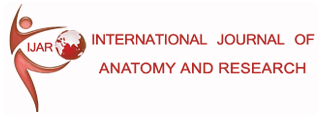
Quick Links


Archives


How
to
cite
this
Article:
Ranjana
G,
Rohini
M,
Manik
C.
ANTHROPOMETRIC
ASSESSMENT
OF
MORPHOLOGICAL
FACIAL
INDEX
OF
GOND
MALES AND FEMALES OF UTTAR BASTAR KANKER, C.G..
Int J Anatomy Res 2016;4(4):3170-3174. DOI: 10.16965/ijar.2016.431.
Type of Article: Original Research
DOI: http://dx.doi.org/10.16965/ijar.2016.431
Page No.: 3170-3174
ANTHROPOMETRIC
ASSESSMENT
OF
MORPHOLOGICAL
FACIAL
INDEX
OF
GOND
MALES
AND
FEMALES
OF
UTTAR
BASTAR
KANKER,
C.G.
Ranjana G
1
, Rohini M *
2
, Manik C
3
.
1
Senior Medical Officer, CHC, Charama, India.
*2
Assistant Professor, Department of Anatomy, MNR Medical College and Hospital, Sangareddy, India.
3
Professor and Head, Department of Anatomy, Pt.J.N.M.Medical College, Raipur, C.G, India.
Corresponding
author:
Dr.
Rohini
Motwani,
Assistant
Professor,
Department
of
Anatomy,
MNR
Medical
College
and
Hospital,
Sangareddy,
Telangana,
India.
Phone no.: +91 9717523402
E-Mail
: rohinimotwani@gmail.com,
ABSTRACT
:
Background:
Anthropometry
(
Greek
:
anthropos-"man
“and
metron-"measure”
therefore
"measurement
of
man")
refers
to
the
measurement
of
the
human
individual.
An
early
tool
of
physical
anthropology
,
it
has
been
used
for
identification,
for
the
purposes
of
understanding
human
physical
variation,
in
paleoanthropology
and in various attempts to correlate physical with racial and psychological traits.
Materials
and
Methods:
The
present
study
was
carried
out
to
demonstrate
the
anthropometric
variation
in
morphological
facial
index
in
both
sexes
of
adult
Gond
of
Uttar
Bastar,
District
Kanker,
Chhattisgarh.
With
100
males
and
100
females
between
age
group
of
18-
45
yrs
were
selected
randomly
who
were
residing
in
different
villages
of
the
district.
Morphological
facial
length
and
bi-zygomatic
breadth
of
these
subjects
were
measured
by
using
calipers
(spreading and sliding).
Statistical
Analysis
:
The
Morphological
facial
index
were
calculated
according
to
the
formula
and
the
obtained
results
were
analyzed
statistically
using
the
t-
test.
Results:
The
mean
values
of
the
Morphological
facial
height,
Bizygomatic
breadth
and
Total
facial
index
in
males
were,
respectively,
11.95±0.68,
13.02±0.61
and
91.13±10
while
the
following
values
of
parameters
were
obtained
in
females,
respectively
were
11.11±0.11,11.95±0.05
and
93.05±8.6.
It
has
been
shown
that
males
in
the
studied
population
have
significantly
higher
values
of
all
measurements
compared
to
the
tested
females
(p
<0.05)
and
differences
were
significant.
The
dominant
type
of
face
phenotype
in
the
studied
population,
according
to
the
value
of
TFI
were
Hyperleptoprosopic
both
in
males
and
females.
Conclusion:
With
the
help
of
this
study,
the
sex
as
well
as
race
of
the
deceased
can
be
determined
accurately
and
this
knowledge
can
be
of
immense
importance
to
anthropologists
as
well
as
forensic
science
experts.
These
results
will
be
very
useful
for
genetic
research,
as
well
as
in
medical
clinical practice.
KEY WORDS: Anthropometry, Bizygomatic breadth, Facial index, Facial phenotype, Morphological facial index.
References
1
.
Topinard
Spencer
1997
p.80
from
Bernard
Haris.
Dictionary
–
Anthropemetry.
Spencer
F.
ed.
(1997)
History
of
physical
anthropology.
Gerland,
New
york and London , Lituanica 2005;12(1):47-53. 1991;58:253-258.
2
.
De Cario D, Metaxas D and Stone M. An Anthropometric face model using variational techniques , proc , SIGGRA PH 98, 1998;32:67 -74 .
3
.
Kolar,
John
C
and
Salter,
Elizabrth
M
,
Craniofacial
anthropometry
practical
measurements
of
the
head
and
face
for
clinical
,surgical
and
research
use
, Chales Thomas publisher Ltd USA-1996.
4
.
Farkas
LG,
Katic
MJ,
Forrest
CR.
Surface
Anatomy
of
the
face
in
Down
Syndrome
:
anthropometric
proportion
indices
in
the
craniofacial
region.
Jr.
Craniofacial surg, 2001;12:519-24.
5
.
S. Rogers. Personal identification from Human Remains , Charles C . Thomas publisher, LTD ,1984.
6
.
volume
rendering:
Bhasin
MK.
Genetics
of
Castes
and
Tribes
of
India:
A
Review
of
Population
Differences
in
Redand
Green
Colour
Vision
Deficiency
in
India. Int JHum Genet, 2006b;6(1):81-8
7
.
Martin,
R.,
and
K.
Saller
(1957).
Lehrbuch
der
anthropologie.
Gustav
Fischer
Verlag,
Stuttgart.
Hajnis
k.
,Farkas
L
G
,Ngim
RCK,Lee
S
T
Venkatadri
G.
,
Racial and Ethnic morphometric differences in craneiofacial coplex, In Farkas L.G. ,Editor Anthropometry of head and face Newyork : 1994, 201.
8
.
Ashok, K.P. Cephalo-facial variation among Onges. Anthropologist 2006;28(4):245-249.
9
.
Shetti et al. Study of proscopic (facial) index of Indian and Malaysian students.Int J Morphol. 2011; 29(3):1018-21.
1
0
.
Hossain,
M.G.,
Saw,
A.,
Ohtsuki,
F.,
Lestrel,
P.E.,
and
T.
Kamarul.
Change
in
facial
shape
in
two
cohorts
of
Japanese
adult
female
students
twenty
years
apart. Singapore Med. J. 2011;52 (11), 818-823.
1
1
.
Rexhepi A, Meka V. Cephalofacial morphological characteristics of Albanian Kosovo population. Int J Morphol. 2008;26(4):935-40.
1
2
.
Mahesh kumar, Mohd. Muzzafar Lone.The Study of Facial Index among Haryanvi Adults. Int J of Sci and Research (IJSR) 2013;2(9):51-53.
1
3
.
Manoharrao Save et al. A study of facial (Prosopic) index of Andhra Region (India) students. Noval Sci Int. J Med Sci. 2012;1(8):248-52.
1
4
.
D.
Jeremić,
Sanja
kocić,
Maja
vulović.
Anthropometric
study
of
the
facial
index
in
the
population
of
central
serbia.
Arch.
Biol.
Sci.
2013;
Belgrade,65(3):1163-1168.
1
5
.
Pavlica,
T.,
Božić-Krstić,
V.,
and
R.
Rakić.
Anthropological
characteristics
of
Montenegrins
living
in
Vojvodina.
Glasnik
Antropološkog
duštva
Jugoslavije.
2007;42:167-177.
1
6
.
Pavlica,
T.,
Božić-Krstić,
V.,
and
R.
Rakić.
Anthropological
characteristics
of
Montenegrins
living
in
Vojvodina.
Glasnik
Antropološkog
duštva
Jugoslavije
2007;42:167-177.
1
7
.
Jeremić
D,
Kocić
SA,
Vulović
MA,
Sazdanović
MA,
Sazdanović
P,
Jovanović
B,
Jovanović
J,
Milanović
Z,
Đonović
NE,
Simović
AL,
PAREZANOVIĆ-ILIĆ
KA.
Anthropometric study of the facial index in the population of central Serbia. Archives of biological sciences. 2013;65(3):1163-8.
1
8
.
Maina,
M.B.,
Shapu,
Y.C.,
Garba,
S.H.,
Muhammad,
M.A.,
Garba,
A.M.,
Yaro,
A.U.,
and
O.N.
Omoniyi.
Assessments
of
cranial
capacities
in
a
North-
Eastern adult Nigerian population. Journal of Applied Sciences 2011;11:2662-2665.
1
9
.
Gohiya,
V.K.,
Shrivatava,
S.,
and
S.
Gohiya
.
Estimation
of
cranial
capacity
in
20-25
year
old
population
of
Madhya
Pradesh
a
State
of
India.
Int.
J.
Morphol. 2010;28 (4):1211-1214.
20.
Ilayperuma, I. Evaluation of cephalic indices: a clue for racial and sex diversity. Int. J. Morphol.2011;29(1):112-117.
Volume 4 |Issue 4.3 | 2016
Date of Publication: 31 December 2016






































